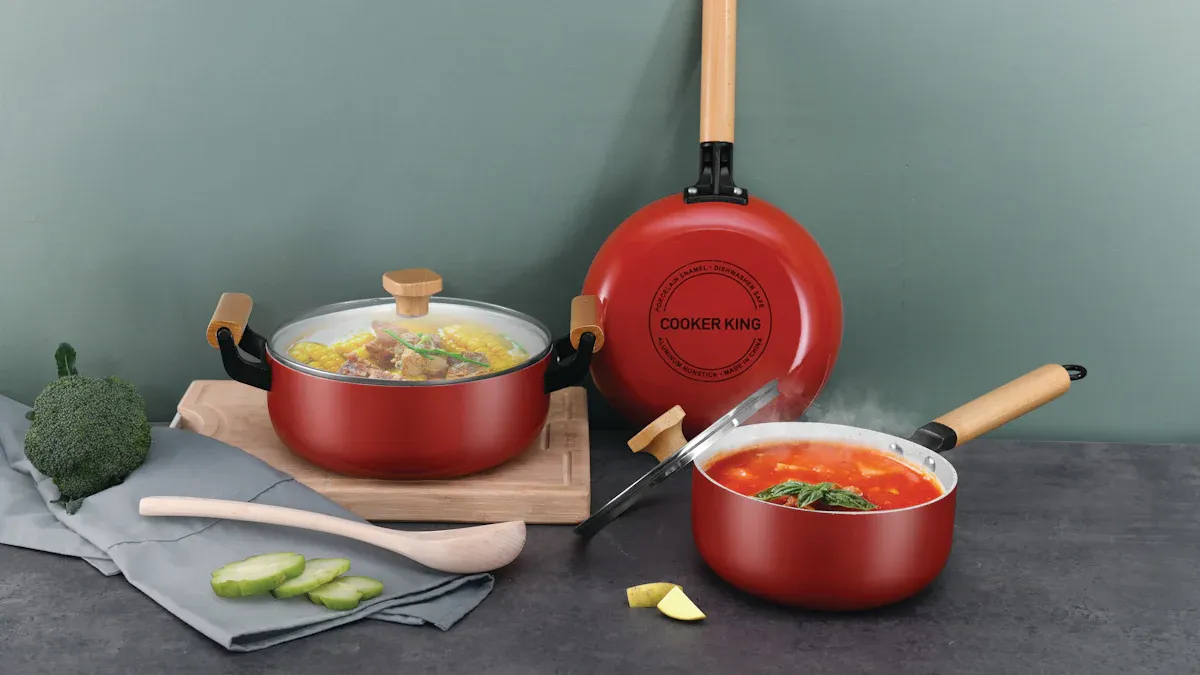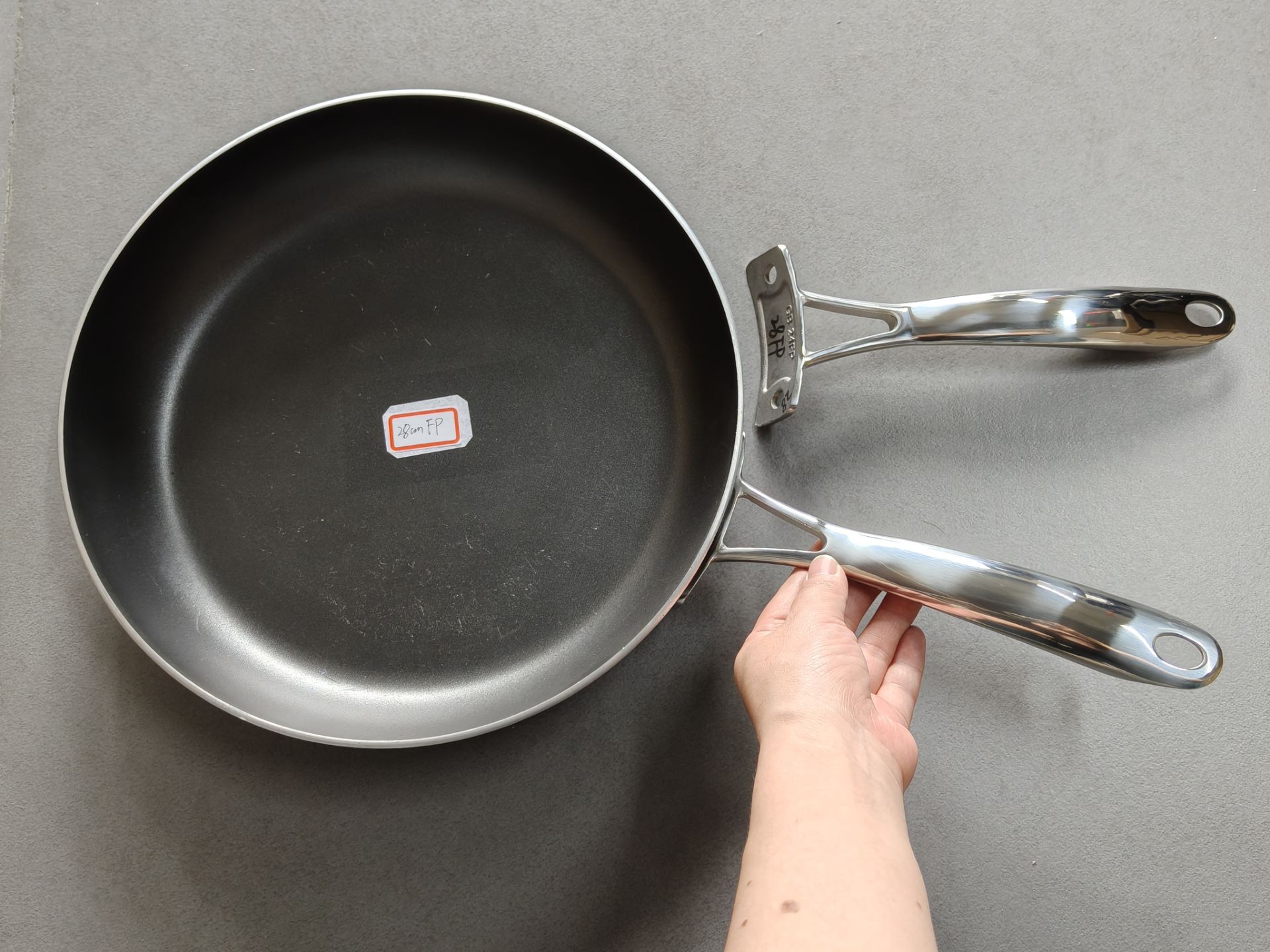Chinese factories produce pot handles using advanced equipment and skilled workers. They select high-quality metals or plastics, shape each pot handle with precision, and test for strength and safety. Many buyers choose these manufacturers because they offer reliable quality, cost savings, and efficient large-scale production.
Key Takeaways
- Chinese factories use advanced machines and skilled workers to produce high-quality pot handles with various materials like stainless steel, aluminum, plastic, and silicone.
- Manufacturers follow strict quality tests and safety standards to ensure durable, safe, and reliable pot handles that meet global requirements.
- Choosing Chinese pot handle makers offers benefits like competitive prices, customization options, and efficient large-scale production with strong global shipping support.
Pot handle materials in China
Stainless steel pot handle
Chinese manufacturers often select stainless steel for its strength and resistance to rust. This material gives a pot handle a shiny look and a long lifespan. Stainless steel handles stay cool longer than many metals. Factories can shape these handles into many designs. Many chefs prefer stainless steel for its professional appearance.
Aluminum pot handle
Aluminum offers a lightweight option for pot handles. Workers can mold aluminum into many shapes. This metal heats up quickly but cools down fast. Aluminum handles cost less than stainless steel. Many cookware brands choose aluminum for its balance of price and performance.
Bakelite and plastic pot handle
Bakelite and plastic handles provide insulation from heat. These materials do not conduct electricity or heat well. Factories can color and shape them in many ways. Bakelite resists high temperatures and does not melt easily. Plastic handles often appear on budget cookware.
Silicone and coated pot handle
Silicone handles feel soft and provide a good grip. They resist heat and do not slip in wet hands. Some pot handles have a silicone or non-stick coating over metal. This coating adds comfort and safety. Many families like silicone for its bright colors and easy cleaning.
Tip: Buyers should match the pot handle material to their needs for safety, comfort, and style.
Pot handle manufacturing processes

Ingection and molding
Chinese factories use die casting and molding to create strong and precise pot handles. Workers pour bakelite Powder or plastic into custom molds. The molds shape the material into the exact form needed. This process allows for complex designs and smooth surfaces. Factories can produce large numbers of handles quickly. Injection works well for bakelite ,while molding suits plastics and silicone. Quality control teams check each batch for defects.
Stamping and forming
Stamping and forming shape metal sheets into pot handles. Machines press the metal into the desired shape using high pressure. This method creates lightweight and durable handles. Factories often use stamping for stainless steel and aluminum. The process reduces waste and keeps costs low. Stamping also allows for different handle styles and sizes.
Note: Stamping and forming help manufacturers meet high-volume orders with consistent quality.
Welding and assembly
Welding joins different parts of a pot handle together. Skilled workers use heat to fuse metal pieces. Some handles require rivets or screws for extra strength. Assembly lines put together all the parts, including grips and coatings. Workers inspect each handle to ensure it meets safety standards. Proper welding and assembly prevent weak spots and improve durability.
Surface finishing and polishing
Surface finishing and polishing give pot handles a smooth and attractive look. Factories use machines and hand tools to remove rough edges. Polishing adds shine and protects against rust. Some handles receive coatings for extra grip or color. Surface finishing also makes cleaning easier. Manufacturers pay close attention to this step to ensure a high-quality product.
Pot handle quality and durability
Material testing for pot handles
Chinese factories use strict material testing to ensure each pot handle meets industry standards. Technicians check metals for strength and resistance to corrosion. They use machines to measure hardness and flexibility. For plastic and silicone handles, they test for heat resistance and chemical stability. These tests help factories select the best materials for safe and long-lasting products.
Durability assessments
Manufacturers perform several durability assessments during production. They simulate real kitchen use by exposing handles to high temperatures and repeated impacts. Some factories use automated machines to twist and pull handles, checking for cracks or breaks. Workers also inspect handles for surface defects. These steps ensure each handle can withstand daily cooking tasks.
Note: Reliable durability testing reduces product returns and increases customer satisfaction.
Safety and compliance certifications
Chinese manufacturers follow strict safety rules. They seek certifications such as LFGB, FDA, or SGS to show compliance with global standards. Inspectors check for sharp edges, loose parts, and toxic substances. Factories keep records of all tests and certifications. Buyers can request these documents to confirm product safety.
A high-quality pot handle must pass all tests before leaving the factory. This process builds trust with buyers and end users.
Pot handle production cost factors
Material costs
Material selection plays a major role in the final price of a pot handle. Stainless steel and high-grade aluminum often cost more than basic plastics or Bakelite. Factories track global market prices for metals and polymers. When prices rise, manufacturers must adjust their quotes. Buyers can compare material options to find the best balance between quality and budget.
Labor and automation
Labor costs in China remain lower than in many Western countries. Many factories invest in automation to reduce manual work. Automated machines shape, assemble, and finish pot handles with speed and accuracy. Skilled workers oversee these machines and handle quality checks. Automation helps factories keep prices competitive while maintaining high standards.
Scale of production
Large orders often lead to lower unit costs. Factories can buy materials in bulk and run machines for longer periods. This efficiency reduces waste and saves money. Small batch production usually costs more per piece. Buyers who order in high volumes benefit from better pricing.
Shipping and export considerations
Shipping adds another layer to the total cost. Factories pack pot handles securely for export. Shipping rates depend on weight, volume, and destination. Export paperwork and customs fees also affect the final price. Many Chinese manufacturers offer support with logistics to help buyers manage these costs.
Tip: Buyers should request detailed quotes that include all cost factors before placing an order.
Why choose Chinese pot handle manufacturers
Advanced manufacturing capabilities
Chinese factories use modern machines and skilled workers to make pot handles. They invest in new technology to improve speed and accuracy. Many factories use robots for tasks like molding and polishing. These advanced systems help them produce large numbers of handles with the same high quality. Factories also follow strict quality checks at every step.
Competitive pricing
Chinese manufacturers offer lower prices than many other countries. They buy materials in bulk and use efficient machines to save money. Lower labor costs also help keep prices down. Buyers can get high-quality pot handles at a better price. Many companies choose China to stay within their budget.
Tip: Buyers can request quotes from several factories to compare prices and services.
Customization and flexibility
Factories in China can make pot handles in many shapes, sizes, and colors. They work with buyers to create custom designs. Some factories offer samples before starting large orders. This flexibility helps brands stand out in the market. Factories can also adjust production quickly if buyers need changes.
Global supply chain integration
Chinese manufacturers ship pot handles to countries all over the world. They work with trusted shipping companies to deliver orders on time. Many factories have experience with export rules and paperwork. This global network helps buyers receive products quickly and safely.
Chinese manufacturers use advanced machines and skilled workers to create high-quality cookware handles. They offer many material choices and efficient production methods. Buyers benefit from reliable quality and cost savings. For those seeking dependable suppliers, China remains a top choice for sourcing kitchen hardware.
FAQ
What materials do Chinese factories use for pot handles?
Chinese factories use stainless steel, aluminum, Bakelite, plastic, and silicone. Each material offers different benefits for durability, heat resistance, and appearance.
How do Chinese manufacturers ensure pot handle quality?
Factories test materials for strength and heat resistance. Workers inspect each handle for defects. Many factories follow international safety standards and provide certifications.
Can buyers request custom pot handle designs?
Yes. Chinese manufacturers offer customization. Buyers can choose shapes, colors, and materials. Factories often provide samples before starting large orders.
Post time: Jul-03-2025


